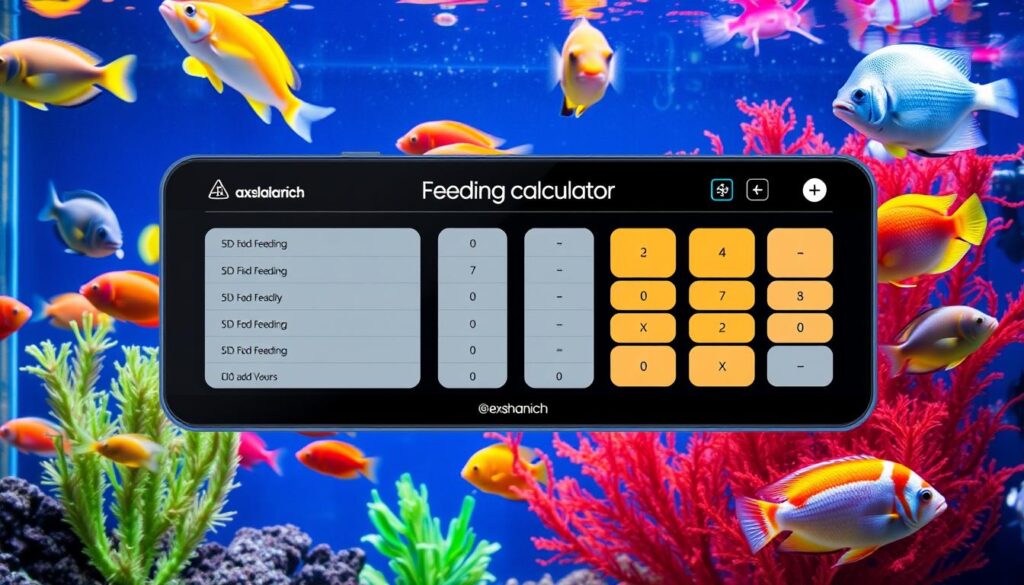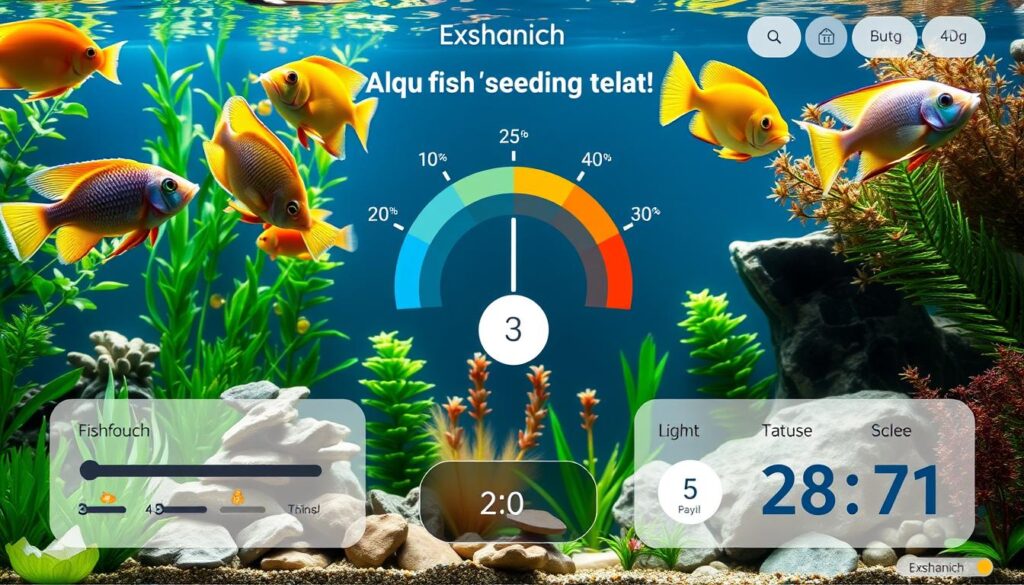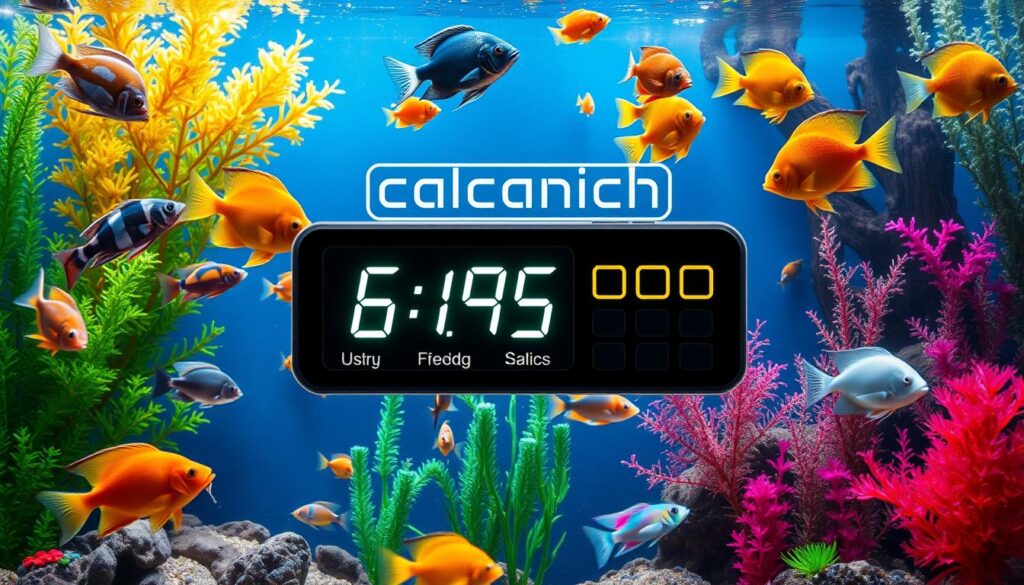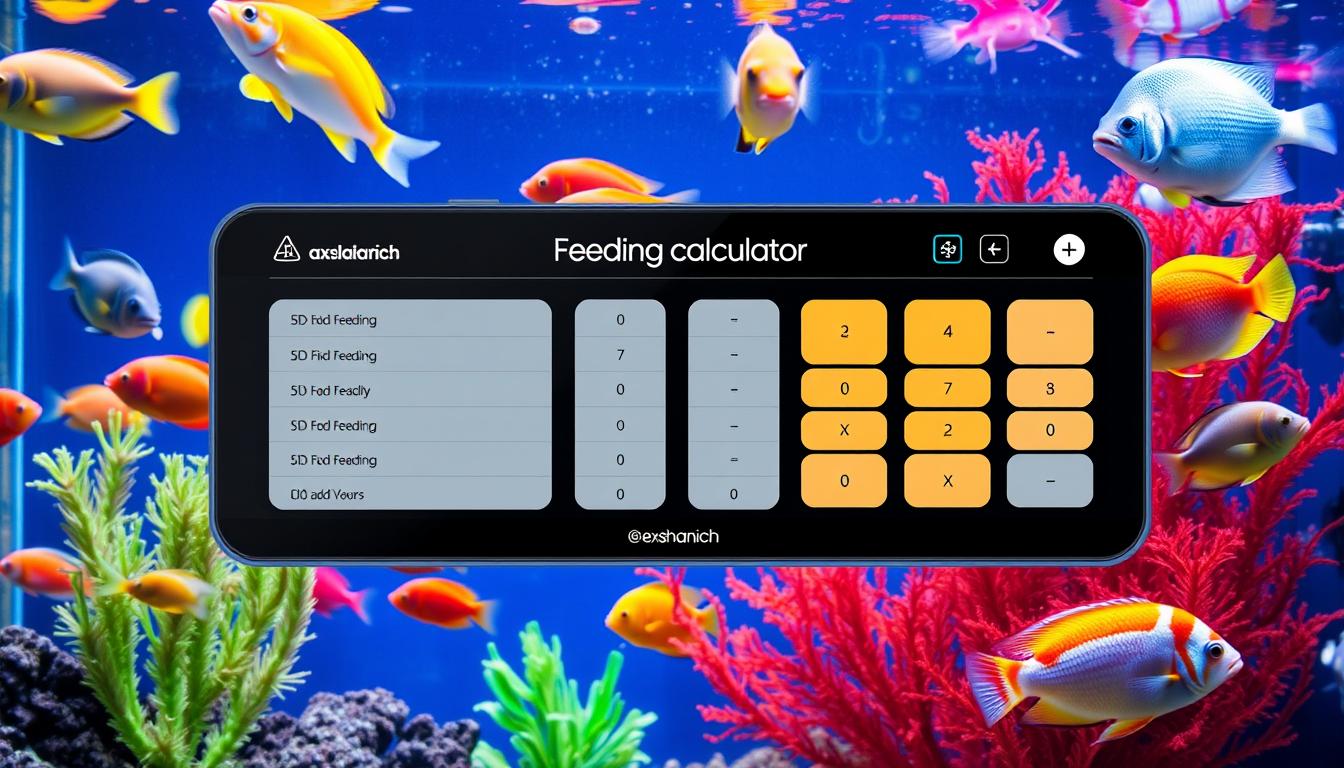Keeping an aquarium healthy is more than just setting it up. It’s about feeding your fish right. The aquarium fish feeding calculator helps you figure out how much to feed them. This ensures they stay healthy and happy.
Feeding your fish correctly is key to their health. It affects their growth, immune system, and energy. Without the right tool, it’s easy to feed them too much or too little. The calculator makes it easy, giving you the right amount based on your fish and tank.

Key Takeaways
- Aquarium fish feeding calculator is a vital tool for ensuring proper nutrition for your aquarium inhabitants
- Proper fish feeding is essential for their health, growth, and overall well-being
- The calculator provides personalized recommendations based on your fish species and tank environment
- Using a feeding calculator can help you avoid over or underfeeding, which can lead to various issues
- Maintaining a balanced feeding routine is a crucial aspect of successful aquarium management
Understanding the Importance of Proper Fish Feeding
Keeping your aquarium fish healthy is very important. Giving them the right amount of food is key. A good fish feeding guide helps them grow well, stay colorful, and full of energy.
Impact of Feeding on Fish Health
What you feed your fish affects their health a lot. Too little food can make them grow slow, weak, and sick. Too much can upset their stomachs, cause metabolic problems, and harm the water.
Finding the perfect balance is crucial. It helps your fish live their best lives.
Common Feeding Mistakes to Avoid
- Inconsistent feeding schedules or erratic portion sizes
- Offering the wrong types of fish food for your specific species
- Failing to account for factors like water temperature and fish activity levels
- Neglecting to properly store and rotate fish food supplies
Signs of Proper Nutrition in Fish
When your fish eat well, you’ll see they’re healthy. They’ll have vibrant colors, be active, grow well, and fight off sickness. Paying attention and making changes helps your fish stay happy and healthy.
“Proper fish feeding is the foundation for a healthy, thriving aquarium ecosystem.”
Aquarium Fish Feeding Calculator: Daily Feeding feed my fish?
Keeping your aquarium fish healthy means feeding them right. An aquarium fish feeding calculator makes this easy. It helps you figure out how much food your fish need.
Using an aquarium fish feeding calculator stops overfeeding. This is good because too much food can harm your fish and the water. It makes sure your fish get the right amount of food for their size, species, and water temperature.
“An aquarium fish feeding calculator is a game-changer for fish owners who want to provide the best possible care for their aquatic pets.”
The aquarium fish feeding calculator also keeps your aquarium healthy. It stops overfeeding, which means less waste in the water. This helps keep the water clean and prevents problems like algae.

Whether you’re new or experienced with aquariums, an aquarium fish feeding calculator is a great tool. It helps you feed your fish just right. This keeps your aquarium balanced and your fish happy.
Different Types of Fish Food and Their Nutritional Value
Feeding your aquarium fish right is key to their health. It’s important to know about the different fish foods and what they offer. We’ll look at dry, frozen, and live foods, and why extra nutrients are important.
Dry Foods vs. Frozen Foods
Dry foods like flakes and pellets are easy to use and last a long time. They have a mix of fish food quantities and important vitamins and minerals. On the other hand, frozen foods like brine shrimp and bloodworms are packed with nutrients and proteins.
Live Food Options
Adding live food to your fish’s diet is great. Foods like daphnia and worms make feeding time fun and natural. They also help your fish feel like they’re hunting.
Supplementary Nutrients
Even with good food, your fish might need extra nutrients. Vitamins and minerals can help them stay healthy and grow well.
| Food Type | Nutritional Value | Pros | Cons |
|---|---|---|---|
| Dry Foods | Balanced fish food quantities and aquarium nutrition | Convenient, shelf-stable | May lack some natural nutrients |
| Frozen Foods | Nutrient-dense, high in natural aquarium nutrition | Closer to natural diet | Requires freezer storage |
| Live Foods | Engage natural foraging, provide varied balanced aquarium diet | Stimulating for fish, natural nutrients | Require more effort to maintain |
Knowing about the different fish foods helps you give your fish a balanced aquarium diet. This ensures they stay healthy and happy.

Factors Affecting Fish Food Portions
Feeding your aquarium fish the right amount is key. The amount of food they need changes based on several important factors. Knowing these factors helps ensure your fish get the right amount of food.
The size and species of the fish are big factors. Smaller fish eat less than bigger ones. Different fish need different foods. Giving the right fish feed amounts helps them stay healthy and grow well.
The age of the fish also matters. Young fish need more food and eat more often than older fish. Changing the portion control for fish as they grow is important for their nutrition.
- Water temperature affects how much food fish need. Warmer water makes fish eat more because they burn more calories.
- How active the fish are is another factor. Active fish need more food to keep up their energy. Less active fish eat less.
By thinking about these factors and adjusting the portion control for fish accordingly, you can make sure your fish are healthy and happy. They will thrive in their home.
| Factor | Impact on Fish Food Portions |
|---|---|
| Fish Size and Species | Smaller fish require less food than larger fish. Different species may have varying nutritional needs. |
| Fish Age | Younger, growing fish need more frequent and larger portions compared to mature fish. |
| Water Temperature | Warmer water temperatures increase fish metabolism, leading to a higher caloric demand and the need for larger food portions. |
| Fish Activity Level | More active fish species require higher fish feed amounts to sustain their energy expenditure. |
“Proper portion control for fish is essential for maintaining their overall health and well-being.”
How to Calculate Daily Fish Food Requirements
Finding the right amount of fish food is key for your aquarium’s health. The aquarium fish feeding calculator helps find the best daily amounts. It considers factors like fish size, species, water temperature, and activity level.
Fish Size and Species Considerations
The size and type of fish matter a lot. Feed them an amount that’s about the size of their eye or the space between their eyes. Larger fish, like cichlids, need more food than smaller, peaceful fish.
Water Temperature Impact
Water temperature affects fish’s metabolism and hunger. In warm water, fish eat more often. In cool water, they eat less. Adjust their food based on your aquarium’s water temperature.
Activity Level Assessment
How active your fish are also matters. Active fish need more calories for their energy. Less active fish need less food. Watch your fish and adjust their food to keep them healthy.
Using the aquarium fish feeding calculator, you can find the perfect daily fish feed. This ensures your fish get the right fish feeding guide to stay healthy.

“Proper feeding is the foundation of a healthy, thriving aquarium ecosystem.”
Best Practices for Portion Control in Fish Feeding
Feeding your aquarium fish the right amount is key. Too much food can cause health problems like bad water quality and digestive issues. Follow these tips to make sure your fish get the nutrition they need without overfeeding.
- Measure and Observe: Use a measuring spoon or device to portion out the right amount of food. Watch how your fish eat and adjust the food amounts as needed.
- Consistent Feeding Schedule: Feed your fish the same amount at the same time every day. This keeps their appetite in check and stops them from eating too much.
- Understand Fish Needs: Each fish species has its own food needs. Learn what your fish need and adjust the food amounts accordingly.

It’s safer to feed a little less than too much. Leftover food can make the water quality bad and cause other issues. By controlling portions, you keep your fish healthy and happy.
“The key to successful fish feeding is finding the right balance between providing adequate nutrition and preventing overfeeding.” – Aquarium Expert, Jane Doe
Also, watch your fish for signs of good health. If they’re active, colorful, and hungry, you’re doing it right.

By following these steps and staying alert, you can feed your fish just the right amount. This keeps your aquarium a healthy and thriving place for them.
Creating a Balanced Feeding Schedule
Keeping your fish healthy means giving them the right food. It’s important to plan their meals well. This ensures they get all the nutrients they need.
Morning vs. Evening Feeding
Feeding time affects how your fish eat and digest food. Feeding in the morning is best, as it matches their natural habits. Evening feeding might be harder, as fish may not be as active. But, some fish like to eat at night, so check what your fish prefer.
Multiple Feeding Sessions
- Break up their daily food into smaller meals.
- This stops overfeeding and keeps their diet balanced.
- Try 2-3 meals a day, a few hours apart, to mimic their natural eating.
Vacation Feeding Plans
When you’re away, make sure your fish eat well. Here are some ideas:
- Ask a trusted friend or family member to feed them.
- Get an automatic feeder to feed them at set times.
- If these options don’t work, consider boarding them at a good aquarium facility.
By planning their meals well, you help your fish stay healthy. Adjust their food plan as needed for changes in their environment or needs.
Monitoring and Adjusting Feeding Amounts
Keeping the right fish feeding schedule is vital for your fish’s health. Watch how your fish act and how they react to the aquarium nutrition you give them. This helps avoid overfeeding fish. By noticing small signs, you can adjust their food just right.
Recognizing Signs of Over or Underfeeding
Watching your fish’s eating habits and looks can tell you a lot. Look for these signs:
- Sluggish or lethargic behavior, which may indicate underfeeding
- Aggressive competition for food or rapid consumption, which could signal overfeeding
- Uneaten food accumulating at the bottom of the tank, a potential sign of overfeeding
- Changes in coloration or body condition, which can be indicators of an imbalanced diet
Adjusting Feeding Amounts
Based on what you see, you can slowly change how much you feed your fish. If they seem hungry, give them more food or feed them more often. If they’re eating too much, feed them less or less often. Finding the perfect amount takes time and might need some trial and error.
| Feeding Adjustment | Recommended Action |
|---|---|
| Underfeeding | Increase portion size or frequency of meals |
| Overfeeding | Reduce portion size or number of feeding sessions |
By watching your fish closely and adjusting their food, you can make sure they get the optimal fish feeding. This keeps your aquarium healthy and your fish happy. A balanced diet and regular feeding are key for your fish’s long-term health.
Conclusion
In this guide, we’ve looked at how important an aquarium fish feeding calculator is. It helps keep your fish healthy by giving them the right food. We’ve talked about why feeding is key and what kinds of food are best for your fish.
Using the tips and tools we’ve shared, you can make sure your fish get the food they need. This includes knowing how much to feed based on their size, water temperature, and how active they are. By controlling portions and following a balanced schedule, you’ll keep your fish happy and healthy.
Happy fish are well-fed fish. With the fish feeding guide from this article, you can make feeding time easier. Follow these tips and watch your aquarium come to life with happy, healthy fish.

FAQ
How much should I feed my aquarium fish each day?
The amount of food your fish need daily depends on several things. This includes the size and type of fish, the water temperature, and how active they are. An aquarium fish feeding calculator can help figure out the right amount for a balanced diet.
What are the common mistakes to avoid when feeding aquarium fish?
Avoid overfeeding to prevent water quality issues and health problems in your fish. Also, don’t underfeed as it can cause stunted growth and poor nutrition. It’s crucial to feed a variety of foods to ensure your fish get all the nutrients they need.
How do I know if my fish are getting the proper nutrition?
Healthy fish are vibrant, active, and grow well. If your fish look dull, move slowly, or don’t grow, they might not be getting enough nutrients. You might need to change their diet.
What types of fish food are available, and which ones are the most nutritious?
There are many fish foods available, like dry, frozen, and live foods. Dry foods like flakes and pellets are easy to use. But, frozen and live foods offer more nutrients. It’s best to mix these to give your fish a balanced diet.
How do water temperature and fish activity level affect the amount of food they need?
Water temperature and how active your fish are affect their food needs. Fish need more food in warm water and less in cool water. Active fish need more calories than sedentary ones.
How can I create a balanced feeding schedule for my aquarium fish?
A consistent feeding routine with small meals throughout the day is best. Consider when your fish prefer to eat. Also, plan for feeding when you’re away to keep their diet balanced.
How do I monitor and adjust my fish’s feeding amounts as needed?
Watch your fish’s behavior, body condition, and waste to see if they need more or less food. Overfeeding can make the water cloudy and harm your fish. Underfeeding can make them weak and slow-growing. Make small changes to their food amounts to keep them healthy.




 No products in the cart.
No products in the cart.